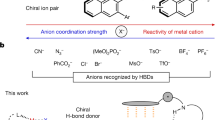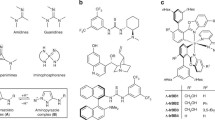Abstract
Cooperative dual catalysis and bifunctional catalysis have emerged as reliable strategies for the development of hitherto difficult asymmetric transformations because they could deliver new reactivity and selectivity, and allow for the employment of substrates not amenable to reaction systems relying on a single, monofunctional catalysts. Furthermore, these modes of catalysis often improve yields and stereoselectivities via the precise recognition and simultaneous activation of nucleophiles and electrophiles. Efforts towards utilizing chiral cationic organic catalysts for asymmetric cooperative catalysis with metal complexes have provided a unique platform to address the challenging issues associated with reaction development. Chiral onium ions, such as tetraalkylammonium, guanidinium, and azolium ions, are employed mainly to control the reactivity and stereochemistry of anionic intermediates through electrostatic and hydrogen-bonding interactions. Metal complexes complement the synergy of the catalysis by activating the substrates via the formation of electrophilic π-allyl complexes, Lewis acid–base adducts, nucleophilic ate complexes, etc. The electrostatic interactions between cations and anions also offer a means to construct complex molecular assemblies, and, thus, onium ions are useful not only for controlling pairing with anionic species, but also for the design of supramolecular catalysts. The combination of onium ions and metal complexes leads to the introduction of novel concepts and powerful strategies for the development of catalysts and chemical transformations.






















Similar content being viewed by others
References
Nelson A (1999) Asymmetric phase-transfer catalysis. Angew Chem Int Ed 38:1583–1585
Maruoka K, Ooi T (2003) Enantioselective amino acid synthesis by chiral phase-transfer catalysis. Chem Rev 103:3013–3028
O’Donnell MJ (2004) The enantioselective synthesis of α-amino acids by phase-transfer catalysis with achiral Schiff base esters. Acc Chem Res 37:506–517
Lygo B, Andrew BI (2004) Asymmetric phase-transfer catalysis utilizing chiral quaternary ammonium salts: asymmetric alkylation of glycine imines. Acc Chem Res 37:518–525
Ooi T, Maruoka K (2007) Recent advances in asymmetric phase-transfer catalysis. Angew Chem Int Ed 46:4222–4266
Hashimoto T, Maruoka K (2007) Recent development and application of chiral phase-transfer catalysts. Chem Rev 107:5656–5682
O’Donnell MJ, Bennett WD, Wu S (1989) The stereoselective synthesis of α-amino acids by phase-transfer catalysis. J Am Chem Soc 111:2353–2355
Lipkowitz KB, Cavanaugh MW, Baker B, O’Donnell MJ (1991) Theoretical studies in molecular recognition: asymmetric induction of benzophenone imine ester enolates by the benzylcinchoninium ion. J Org Chem 56:5181–5192
Ooi T, Kameda M, Maruoka K (1999) Molecular design of a C 2-symmetric chiral phase-transfer catalyst for practical asymmetric synthesis of α-amino acids. J Am Chem Soc 121:6519–6520
Ooi T, Kameda M, Maruoka K (2003) Design of N-spiro C2-symmetric chiral quaternary ammonium bromides as novel chiral phase-transfer catalysts: synthesis and application to practical asymmetric synthesis of α-amino acids. J Am Chem Soc 125:5139–5151
Kitamura M, Shirakawa S, Maruoka K (2005) Powerful chiral phase-transfer catalysts for the asymmetric synthesis of α-alkyl- and α, α-dialkyl-α-amino acids. Angew Chem Int Ed 44:1549–1551
Chen G, Deng Y, Gong L, Mi A, Cui X, Jiang Y, Choi MCK, Chan ASC (2001) Palladium-catalyzed allylic alkylation of tert-butyl (diphenylmethylene)-glycinate with simple allyl esters under chiral phase transfer conditions. Tetrahedron Asymmetry 12:1567–1571
Nakoji M, Kanayama T, Okino T, Takemoto Y (2001) Chiral phosphine-free Pd-mediated asymmetric allylation of prochiral enolate with a chiral phase-transfer catalyst. Org Lett 3:3329–3331
Nakoji M, Kanayama T, Okino T, Takemoto Y (2002) Pd-catalyzed asymmetric allylic alkylation of glycine imino ester using a chiral phase-transfer catalyst. J Org Chem 67:7418–7423
Wuts PGM, Ashford SA (2008) A new approach to the synthesis of the carbon framework of SC-84536, an inducible nitric oxide synthase inhibitor. Tetrahedron Lett 49:4033–4035
Kanayama T, Yoshida K, Miyabe H, Kimachi T, Takemoto Y (2003) Synthesis of β-substituted α-amino acids with use of iridium-catalyzed asymmetric allylic substitution. J Org Chem 68:6197–6201
Kanayama T, Yoshida K, Miyabe H, Takemoto Y (2003) Enantio- and diastereoselective Ir-catalyzed allylic substitutions for asymmetric synthesis of amino acid derivatives. Angew Chem Int Ed 42:2054–2056
Su YL, Li YH, Chen YG, Han ZY (2017) Ir/PTC cooperatively catalyzed asymmetric umpolung allylation of α-imino ester enabled synthesis of α-quaternary amino acid derivatives bearing two vicinal stereocenters. Chem Commun 53:1985–1988
Wu Y, Hu L, Deng L (2015) Catalytic asymmetric umpolung reactions of imines. Nature 523:445–450
Ooi T, Uematsu Y, Maruoka K (2006) Asymmetric Strecker reaction of aldimines using aqueous potassium cyanide by phase-transfer catalysis of chiral quaternary ammonium salts with a tetranaphthyl backbone. J Am Chem Soc 128:2548–2549
Ooi T, Ohara D, Tamura M, Maruoka K (2004) Design of new chiral phase-transfer catalysts with dual functions for highly enantioselective epoxidation of α, β-unsaturated ketones. J Am Chem Soc 126:6844–6845
Uyanik M, Okamoto H, Yasui T, Ishihara K (2010) Quaternary ammonium (hypo)iodite catalysis for enantioselective oxidative cycloetherification. Science 328:1376–1379
Bhunnoo RA, Hu Y, Lainé DI, Brown RCD (2002) An asymmetric phase-transfer dihydroxylation reaction. Angew Chem Int Ed 41:3479–3480
Wang C, Zong L, Tan CH (2015) Enantioselective oxidation of alkenes with potassium permanganate catalyzed by chiral dicationic bisguanidinium. J Am Chem Soc 137:10677–10682
Ye X, Moeljadi AMP, Chin KF, Hirao H, Zong L, Tan CH (2016) Enantioselective sulfoxidation catalyzed by a bisguanidinium diphosphatobisperoxotungstate ion pair. Angew Chem Int Ed 55:7101–7105
Sato K, Aoki M, Ogawa M, Hashimoto T, Noyori R (1996) A practical method for epoxidation of terminal olefins with 30% hydrogen peroxide under halide-free conditions. J Org Chem 61:8310–8311
Sato K, Hyodo M, Aoki M, Zheng XQ, Noyori R (2001) Oxidation of sulfides to sulfoxides and sulfones with 30% hydrogen peroxide under organic solvent- and halogen-free conditions. Tetrahedron 57:2469–2476
Yamada S, Mashiko T, Terashima S (1977) (Acetylacetonato) [(–)-N-alkylephedrinato]dioxomolybdenum, a new class of chiral chelate complexes which catalyze asymmetric epoxidation of allylic alcohol. J Am Chem Soc 99:1988–1990
Basak A, Barlan AU, Yamamoto H (2006) Catalytic enantioselective oxidation of sulfides and disulfides by a chiral complex of bis-hydroxamic acid and molybdenum. Tetrahedron Asymmetry 17:508–511
Dickman MH, Pope MT (1994) Peroxo and superoxo complexes of chromium, molybdenum, and tungsten. Chem Rev 94:569–584
Zong L, Wang C, Moeljadi AMP, Ye X, Ganguly R, Li Y, Hirao H, Tan CH (2016) Bisguanidinium dinuclear oxodiperoxomolybdosulfate ion pair-catalyzed enantioselective sulfoxidation. Nat Commun 7:13455
Paria S, Lee HJ, Maruoka K (2019) Enantioselective alkynylation of isatin derivatives using a chiral phase-transfer/transition-metal hybrid catalyst system. ACS Catal 9:2395–2399
Blay G, Monleon A, Pedro JR (2009) Recent developments in asymmetric alkynylation of imines. Curr Org Chem 13:1498–1539
Trost BM, Weiss AH (2009) The enantioselective addition of alkyne nucleophiles to carbonyl groups. Adv Synth Catal 351:963–983
Sawamura M, Ito Y (1992) Catalytic asymmetric synthesis by means of secondary interaction between chiral ligands and substrates. Chem Rev 92:857–871
Shibasaki M, Yoshikawa N (2002) Lanthanide complexes in multifunctional asymmetric catalysis. Chem Rev 102:2187–2209
Ma J-A, Cahard D (2004) Towards perfect catalytic asymmetric synthesis: dual activation of the electrophile and the nucleophile. Angew Chem Int Ed 43:4566–4583
Kull T, Peters R (2008) Contact ion pair directed Lewis acid catalysis: asymmetric synthesis of trans-configured β-lactones. Angew Chem Int Ed 47:5461–5464
Kull T, Cabrera J, Peters R (2010) Catalytic asymmetric synthesis of trans-configured β-lactones: cooperation of Lewis acid and ion pair catalysis. Chem Eur J 16:9132–9139
Meier P, Broghammer F, Latendorf K, Rauhut G, Peters R (2012) Cooperative Al(salen)-pyridinium catalysts for the asymmetric synthesis of trans-configured β-lactones by [2 + 2]-cyclocondensation of acylbromides and aldehydes: investigation of pyridinium substituent effects. Molecules 17:7121–7150
Kurono N, Ohkuma T (2016) Catalytic asymmetric cyanation reactions. ACS Catal 6:989–1023
Brodbeck D, Broghammer F, Meisner J, Klepp J, Garnier D, Frey W, Kästner J, Peters R (2017) An aluminum fluoride complex with an appended ammonium salt as an exceptionally active cooperative catalyst for the asymmetric carboxycyanation of aldehydes. Angew Chem Int Ed 56:4056–4060
Brodbeck D, Álvarez-Barcia S, Meisner J, Broghammer F, Klepp J, Garnier D, Frey W, Kästner J, Peters R (2019) Asymmetric carboxycyanation of aldehydes by cooperative AlF/onium salt catalysts: from cyanoformate to KCN as cyanide source. Chem Eur J 25:1515–1524
Broghammer F, Brodbeck D, Junge T, Peters R (2017) Cooperative Lewis acid–onium salt catalysis as tool for the desymmetrization of meso-epoxides. Chem Commun 53:1156–1159
Schulze B, Schubert US (2014) Beyond click chemistry–supramolecular interactions of 1,2,3-triazoles. Chem Soc Rev 43:2522–2571
Cai J, Sessler JL (2014) Neutral CH and cationic CH donor groups as anion receptors. Chem Soc Rev 43:6198–6213
Ohmatsu K, Kiyokawa M, Ooi T (2011) Chiral 1,2,3-Triazoliums as new cationic organic catalysts with anion-recognition ability: application to asymmetric alkylation of oxindoles. J Am Chem Soc 133:1307–1309
Ohmatsu K, Ando Y, Nakashima T, Ooi T (2016) A modular strategy for the direct catalytic asymmetric α-amination of carbonyl compounds. Chem 1:802–810
Chen S-K, Ma W-Q, Yan Z-B, Zhang F-M, Wang S-H, Tu Y-Q, Zhang X-M, Tian J-M (2018) Organo-cation catalyzed asymmetric homo/heterodialkylation of bisoxindoles: construction of vicinal all-carbon quaternary stereocenters and total synthesis of (−)-chimonanthidine. J Am Chem Soc 140:10099–10103
Mechler M, Peters R (2015) Diastereodivergent asymmetric 1,4-addition of oxindoles to nitroolefins by using polyfunctional nickel-hydrogen-bond-azolium catalysts. Angew Chem Int Ed 54:10303–10307
Krautwald S, Sarlah D, Schafroth MA, Carreira EM (2013) Enantio- and diastereodivergent dual catalysis: α-allylation of branched aldehydes. Science 340:1065–1068
Sandmeier T, Krautwald S, Zipfel HF, Carreira EM (2015) Stereodivergent dual catalytic α-allylation of protected α-amino- and α-hydroxyacetaldehydes. Angew Chem Int Ed 54:14363–14367
Schmid J, Junge T, Lang J, Frey W, Peters R (2019) Polyfunctional bis-Lewis-acid-/bis-triazolium catalysts for stereoselective 1,4-additions of 2-oxindoles to maleimides. Angew Chem Int Ed 58:5447–5451
Satyanarayana T, Abraham S, Kagan HB (2009) Nonlinear effects in asymmetric catalysis. Angew Chem Int Ed 48:456–494
Ohmatsu K, Imagawa N, Ooi T (2014) Ligand-enabled multiple absolute stereocontrol in metal-catalysed cycloaddition for construction of contiguous all-carbon quaternary stereocentres. Nat Chem 6:47–51
Schärer K, Morgenthaler M, Seiler P, Diederich F (2004) Enantiomerically pure thrombin inhibitors for exploring the molecular-recognition features of the oxyanion hole. Helv Chim Acta 87:2517–2538
Ohmatsu K, Kawai S, Imagawa N, Ooi T (2014) Palladium-catalyzed asymmetric [3 + 2] cycloaddition of 5-vinyloxazolidinones with imines using chiral ammonium- phosphine hybrid ligand. ACS Catal 4:4304–4306
Reetz MT (2009) Directed evolution of enantioselective enzymes: an unconventional approach to asymmetric catalysis in organic chemistry. J Org Chem 74:5767–5778
Reetz MT (2011) Laboratory evolution of stereoselective enzymes: a prolific source of catalysts for asymmetric reactions. Angew Chem Int Ed 50:138–174
Müller M (2012) Recent developments in enzymatic asymmetric C-C bond formation. Adv Synth Catal 354:3161–3174
Breit B (2008) Catalysts through self-assembly for combinatorial homogeneous catalysis. Pure Appl Chem 80:855–860
Meeuwissen J, Reek JNH (2010) Supramolecular catalysis beyond enzyme mimics. Nat Chem 2:615–621
Ohmatsu K, Ooi T (2015) Design of supramolecular chiral ligands for asymmetric metal catalysis. Tetrahedron Lett 56:2043–2048
Ohmatsu K, Ito M, Kunieda T, Ooi Takashi (2012) Ion-paired chiral ligands for asymmetric palladium catalysis. Nat Chem 4:473–477
Akiyama T (2007) Stronger Brønsted acids. Chem Rev 107:5744–5758
Terada M (2010) Chiral phosphoric acids as versatile catalysts for enantioselective transformations. Synthesis 2010:1929–1982
Phipps RJ, Hamilton GL, Toste FD (2012) The progression of chiral anions from concepts to applications in asymmetric catalysis. Nat Chem 4:603–614
Mahlau M, List B (2012) Asymmetric counteranion-directed catalysis: concept, definition, and applications. Angew Chem Int Ed 52:518–533
Brak K, Jacobsen EN (2013) Asymmetric ion-pairing catalysis. Angew Chem Int Ed 52:534–561
Ohmatsu K, Ito M, Ooi T (2014) Ligand-controlled E/Z selectivity and enantioselectivity in palladium-catalyzed allylation of benzofuranones with 1,2-disubstituted allylic carbonates. Chem Commun 50:4554–4557
Ohmatsu K, Ito M, Kunieda T, Ooi T (2013) Exploiting the modularity of ion-paired chiral ligands for palladium-catalyzed enantioselective allylation of benzofuran-2(3H)-ones. J Am Chem Soc 135:590–593
Wieland J, Breit B (2010) A combinatorial approach to the identification of self-assembled ligands for rhodium-catalysed asymmetric hydrogenation. Nat Chem 2:832–837
Ohmatsu K, Hara Y, Ooi T (2014) In situ generation of ion-paired chiral ligands: rapid identification of the optimal ligand for palladium-catalyzed asymmetric allylation. Chem Sci 5:3645–3650
Author information
Authors and Affiliations
Corresponding author
Additional information
Publisher's Note
Springer Nature remains neutral with regard to jurisdictional claims in published maps and institutional affiliations.
This article is part of the Topical Collection “Asymmetric Organocatalysis Combined with Metal Catalysis”; edited by Bruce A. Arndtsen, Liu-Zhu Gong.
Rights and permissions
About this article
Cite this article
Ohmatsu, K., Ooi, T. Cationic Organic Catalysts or Ligands in Concert with Metal Catalysts. Top Curr Chem (Z) 377, 31 (2019). https://doi.org/10.1007/s41061-019-0256-1
Received:
Accepted:
Published:
DOI: https://doi.org/10.1007/s41061-019-0256-1




